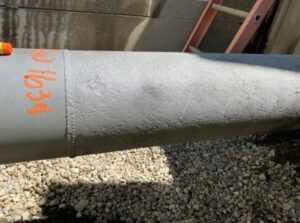Key Takeaways
- Pipeline operation and maintenance in winter tends to cost more and take longer
- Special considerations apply, such as equipment needing more time each morning to warm up
- Written procedures need to take into account the realities of winter work
- Getting good at winter operations can be a key competitive advantage for your company
- A third-party firm can help you make sure your project plans and procedures are appropriate for winter
Let’s say you embarked on a major refit of some valves on your line back in September. But the project got delayed. Maybe it was the unexpected need for an environmental permit, a key fitting that got back-ordered, or a subcontractor that wasn’t able to start right away. Now it’s late November, and you’ve still got several weeks of work to do. You didn’t choose to be doing this maintenance in winter, but that’s where you’re at.
Maybe you understand how Napoleon may have felt in 1812. He took on a big project, too, when the weather was warm – his Russian campaign. However, a few delays and setbacks later, Napoleon was just trying to survive a Russian winter and get back to France.
But, as we’ve found here at Acuren, it’s possible to achieve excellence in winter projects so that you don’t just survive the season – you can actually thrive.
Due to high demand for energy during the coldest months, there is a good chance that emergencies will come up that you must respond to in order to keep the line running. Being good at winter work allows you to respond promptly to system and customer needs, provide reliable service, and meet regulatory deadlines.
Here are some success factors for construction, repair, and maintenance in winter. This post follows from another previous one about how to design a pipeline system to meet winter’s realities.

What’s good about field operations and maintenance in winter?
While Napoleon might have disagreed, there are some advantages to doing field work in winter.
One is that more equipment is available for rent, and generally at lower rates. Also, skilled contractors are more readily available – and maybe at lower rates as well.
There are no mosquitos, blackflies, deerflies, or ticks out … (okay, it’s not much, but work with us here).
As any hiker, hunter, or skier will attest, “There’s no such thing as bad weather. Just bad gear.” The right insulated boots, coveralls, headgear, and gloves can take the pain out of winter work, and even allow personnel to enjoy it.
What’s harder about field operations and maintenance in winter?
On the other hand, everything takes longer in winter. For example, there’s the time needed to get heavy equipment warmed up and ready to work. When excavating, frozen soil requires more work to remove. Then at the end of the day, that equipment must be set on solid ground out of the mud so it won’t be frozen in place the next morning.
Crews need to wear heavier, more restrictive clothing, and this slows them down. They may also need to take breaks in the truck just to warm up.
It gets light later and dark earlier, so there may be more need for light plants and possibly a generator – all of which must be transported to the job site, set up and then taken down.
There’s more wear and tear on equipment. The upper layer of soil may be frozen, so it doesn’t break up easily, and this is hard on shovel blades and hydraulics, as well as equipment operators. You may need to budget more time and money for equipment maintenance and repair.
In general, projects don’t flow as smoothly as they would in warmer weather, so this must be accepted and factored into budgets and timelines.
The benefits of established procedures for maintenance in winter
As you may have read in our post on the value of written procedures, it is important that field staff have a clear idea of the steps required to do the work. That particularly applies in winter, given the number of things that can go wrong and the potential for injury related to cold temperatures.
These procedures need to recognize that some work is simply different in winter. This includes transporting water in sub-freezing temperatures, and the possible need to add glycol or some other form of anti-freeze, which means additional disposal considerations, longer timelines, and higher costs.
Pouring concrete is different too, with a need to prevent the concrete from freezing before it cures. Soil removed from an excavation may also need to be kept from freezing, so it doesn’t turn into a solid pile of unworkable ice before it’s put back into the trench.
For applying coatings, it may be necessary to specify those formulated to do well at cold temperatures.
You may need to prepare procedures for work only done in winter, like the steps for clearing snow off a work site, for welders pre-heating pipe, and safely erecting and heating tent shelters when necessary.
To create procedures that work, it’s important to think of what’s different about working in winter, and what tasks need to be added or changed.
Allow for longer timelines in winter
Add a realistic ‘winter factor’ to your timelines and schedules, recognizing that everything takes longer.
There may be many tasks at the start of the day – like clearing snow off and warming up equipment, and also at the end of the day. They may not be “productive” in the sense of getting sleeves on pipe or pipe in the ground, but which are necessary to getting the work done.
Factor in higher costs
Just as timelines can stretch in winter, so can budgets. In addition to the increased hours billed, there will be higher fuel costs, partly to warm up heavy equipment to make it usable, running light plants, and idling engines just to give workers a chance to warm up.
There is also a higher chance that tools and parts will be lost, due to darkness , mud, and snow. So, be prepared to order replacements or to have redundant equipment and supplies on hand.
Work with an experienced engineering firm
Firms such as Acuren can help you in several areas:
- Putting together procedures, work plans, specifications, and scope of work packages that will succeed in a winter context.
- We understand cold weather work, so when we ask contractors to provide a proposal, we can describe what needs to be done, and cold-weather protections and procedures that must be followed.
- We can review bids and proposals that may have been appropriate when the project was planned for September, but which must now be completed in January. We can advise what scope, schedule, and cost factors will change, and provide modified documents with a “winter” factor added.



